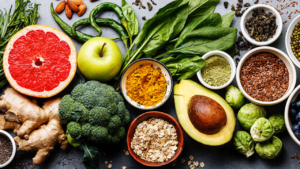Introduction
Balancing food and physical activity is basic to achieving maximum wellness, maintaining energy, and preventing chronic diseases. Nutrition works as the fuel your body needs to function best, whereas regular physical activity ensures that the energy consumed is effectively used. Together they create a synergy that promotes not only physical fitness but also mental well-being and the quality of life.
This article discusses how to have a healthy balance of food and exercise, provides useful tips, and answers some frequently asked questions that will lead you to have a healthier lifestyle.
Balancing Food with Physical Activity
Food supplies your body with needed calories for daily activities, including exercise. Your weight goes up when you consume more calories than you burn. When you burn more calories than you consume, you lose weight. Beyond keeping or losing weight, this balance affects:
Building and repairing muscles.
Metabolic health.
Your mental clarity and focus.
Reducing your risk of chronic conditions such as diabetes and heart disease.
Knowing the Role of Food in Exercise
1. Aims or Objectives of Macronutrients and Their Functions
Carbohydrates: The body’s preferred energy source, especially for high-intensity activities.
Found in: Whole grains, fruits, and starchy vegetables.
Proteins: For building, repair, or replacement of muscles.
Found in: Lean meats, eggs, dairy, beans, and tofu.
Fats: A secondary source of energy, especially for endurance activities.
Found in: Nuts, seeds, avocados, and fatty fish.
2. Timing Your Meals for Exercise
Pre-Workout: Consume a well-balanced meal 2-3 hours prior to exercise; it should contain an abundance of carbs, accompanied by adequate amounts of protein.
Post-Workout: Replenish within 30-60 minutes after exercising with a mix of carbs and proteins to promote muscle repair.
Physical Activity and Its Importance for Health
1. Categories of Physical Activity
Aerobic Exercise-Activities that involve running, cycling, swimming, etc., which enhance cardiovascular health.
Strength Training-Includes lifting weights and doing resistance exercises that tone muscles and increase bone density.
Flexibility Exercises: Yoga or stretching routines that improve range of motion and reduce the risk of injuries.
2. Benefits of Regular Exercise
Helps to improve cardiovascular health and endurance.
Maintains healthy weight.
It has been shown that regular exercise releases endorphins which help in improving mood.
It strengthens bones and muscles.
How to Achieve a Good Balance between Food and Physical Activities

1. Caloric Intake and Activity Level
Calorie intake should be proportional to energy expenditure. For example:
High activity level: Increase intakes of carbohydrate as well as protein.
Low activity level: Eat nutrient-dense foods but pay close attention to portion sizes.
2. Hydrate
Water is essential in maintaining the body’s temperature, and in assisting the muscles, and preventing water fatigue. Drink water throughout the day, as well as with workouts.
3. Do not overindulge after exercise
After exercising, restocking calories are extremely important, but excessive calorie intake cancels out some of the benefits of physical activity. Emphasize balanced meals rather than high-calorie snacks.
4. Pre-workout meals
Pre-workout
For morning workouts: Snack on light food such as a banana or yogurt before exercising
For evening workouts: Eat a balanced lunch but lighter dinner post-exercising
5. Resting Days
Resting is essential for recovery and avoiding burnout. On such days, let proper nutrition and hydration be key.
Frequently Asked Questions (FAQs)
Q1: How many meals should I eat daily to balance food and exercise?
A: Aim for 3 balanced meals and 1-2 snacks, depending on your activity level. Adjust portion sizes to match your energy needs.
Q2: Can I exercise on an empty stomach?
A: Although some individuals can work very well in a fasted state (e.g., fasted cardio), they may begin to feel fatigued or dizzy. Some form of snack should be consumed prior to exercise.
Q3: How much protein for muscle recovery?
A: The recommended intake of proteins for most active people is between 1.2 and 2.0 grams per kilogram of body weight per day, depending upon the intensity of activity.
Q4: Can I let loose on foods if I work out?
A: Yes, moderate amounts of treats are acceptable in the diet if taken in moderation. Life must be well-balanced.
Q5: How can I keep myself hydrated while exercising for an extended period?
A: Drink water before, during, and after exercise. For extended workout periods greater than an hour, it is recommended to consume electrolyte drinks for replenishment of lost minerals.
Conclusion
Being in balance with food and physical activity is not a diet or rampant exercise; it is more of achieving a lifestyle. Understanding nutrition and its relationship with exercise can contribute to making informed decisions that will enhance performance, recovery, and overall well-being. Remember, little by little, goes a long way toward achieving success for a healthy, balanced life.